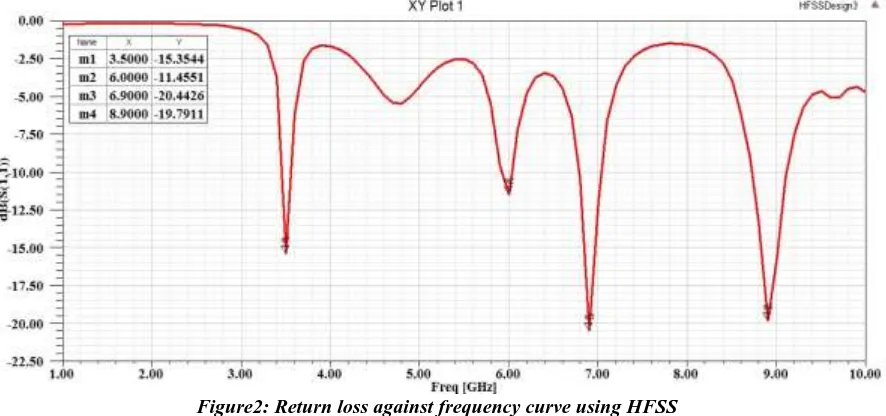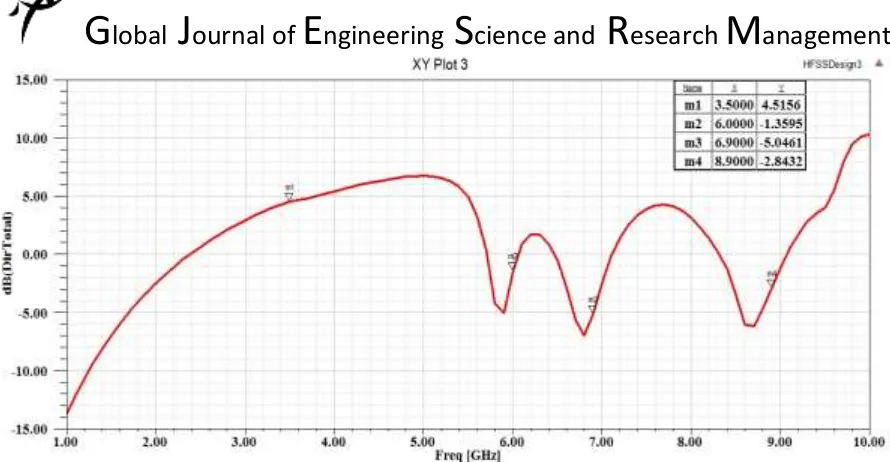[Mishra* 4(9): September, 2017] ISSN 2349-4506
Impact Factor: 2.785
G
lobal
J
ournal of
E
ngineering
S
cience and
R
esearch
M
anagement
CALCULATION OF MICROSTRIP PATCH ANTENNA PARAMETERS USING
ARTIFICIAL NEURAL NETWORK
Kavita Mishra*, Rohini Saxena, Mukesh Kumar, Meenakshi Kumari, Ajay Singh *Dept. of Electronics and communication engineering, SIET, SHUATS, INDIA
DOI: 10.5281/zenodo.886923
KEYWORDS
:
Return loss, VSWR, Directivity, HFSS, Artificial Neural network.ABSTRACT
In this paper, a comparison of Microstrip patch antenna parameters returns loss, VSWR and directivity between using HFSS Software and Artificial Neural Network. In this antenna achieved four resonant frequency 3.5 GHz, 6 GHz, 6.9 GHz and 8.9GHz using substrate material Fr-4 Glass epoxy substrate with using co-axial feeding technique. An ANN has been developed for the calculation of return loss, VSWR and directivity of resonant microstrip antenna using MATLAB and compare with HFSS’s antenna parameters. The resonated frequencies lies in S, C and X bands. Results of the ANN network are compared with the data obtained from HFSS software and concluded that ANN results are in good agreement as compared to HFSS.
INTRODUCTION
The significance of wireless communication has increased rapidly as per the development of wireless equipment’s used for communication purposes. As due to the advancement of wireless technology there is a certain need for the contribution in the field of antennas. It is a device with unique feature that they follow the process of radiation and receive those radiation in the form of electromagnetic waves they are used widely in, WLAN, GPS, mobile phones and other means of communication devices. They are easy to develop as they are light in weight, low in cost and maintain high performances for spectrum of high frequencies. The microstrip antennas are considered best for wireless communication as they constitute coplanar configuration. The co-axial feed technique has an important feature of impedance matching which further contributes in Maximum power transmission.
This paper concentrates on the development of neural network for the circuits with highly nonlinear response. Thus, the networks are built by multi-layer perceptron (MLP) network with relatively large no. of neurons were used to achieve the results accurately.
In this paper a 40 mm × 30 mm ×1.57 mm dimension antenna has been designed for comparison of antenna parameters between HFSS and ANN. The designed antenna using co-axial feeding technique with substrate material Fr-4 glass epoxy substrate. The proposed antenna has resonated at four frequencies which lies in S, C and X bands. This antenna is used for various wireless devices like Wi-Max, Wi- Fi and microwave communication devices.
ARTIFICIAL NEURAL NETWORK
ANN is used for adaptive controllers, modeling as Active and passive devices enhancing of microwaves circuit modeling. It is a combination of electronic hardware and software similar to the interconnection of nodes in human brain composition of ANN required nonlinear function in blocks of neurons. Neurons are connected with weights can be reduced or strengthen as per the given input pattern and o/p produced as feed forward network. This ANN operates at high speed and using ANN approach the return loss, directivity and VSWR is calculated.
ANTENNA DESIGN
[Mishra* 4(9): September, 2017] ISSN 2349-4506
Impact Factor: 2.785
G
lobal
J
ournal of
E
ngineering
S
cience and
R
esearch
M
anagement
in applications such as circular polarization and high frequency multi frequency applications. The basic antenna element is composed of conducting material of dimension Length × Width on direct substrate of permittivity (εr)and thickness (h) is to be backed by conducting ground plane.
The proposed rectangular microstrip patch antenna having dimension 40 × 30 × 1.57 mm3. The coaxial feed line
is used with substrate permittivity εr = 4.4, substrate thickness h = 1.57 mm at operating frequency f = 5 GHz. The
designed antenna shown in Figure 1.
Table. I Dimensions of Proposed Microstrip multiband antenna.
S. N. Parameters Dimension
1. Ground Length Lg 40 mm
2. Ground Width Wg 30 mm
3. Patch Length Lp 20 mm
4. Patch Width Wp 15 mm
5. Substrate thickness h 1.57mm
[Mishra* 4(9): September, 2017] ISSN 2349-4506
Impact Factor: 2.785
G
lobal
J
ournal of
E
ngineering
S
cience and
R
esearch
M
anagement
RESULTS AND DISCUSSION
The Return loss verse frequency are obtained by HFSS is shown in Figure 3. The VSWR verse frequency is shown in Figure 4. The Directivity is shown in Figure 5. The radiation pattern for the frequency band 3.5 GHz, 6 GHz, 6.9 GHz and 8.9GHz is shown in Figure 6. These results are obtained with the help of HFSS. Table (II) depicts for Directivity, VSWR and Return loss using HFSS.
Figure2: Return loss against frequency curve using HFSS
[Mishra* 4(9): September, 2017] ISSN 2349-4506
Impact Factor: 2.785
G
lobal
J
ournal of
E
ngineering
S
cience and
R
esearch
M
anagement
Figure 4: Directivity against frequency curve using HFSS
Table II: HFSS Data for return loss, VSWR and directivity
S.
No. Frequency Return loss VSWR Directivity
1 3.5 GHZ -15.3544 1.4117 4.5156
2 6 GHZ -11.4551 1.7302 -1.3595
3 6.9 GHZ -20.4426 1.2100 -5.0461
[Mishra* 4(9): September, 2017] ISSN 2349-4506
Impact Factor: 2.785
G
lobal
J
ournal of
E
ngineering
S
cience and
R
esearch
M
anagement
Figure 5(a): Radiation Pattern for 3.5 GHz Figure 5(b): Radiation Pattern for 6 GHz
Figure 5(c): Radiation Pattern for 6.9 GHz Figure 5(d): Radiation Pattern for 8.9 GHz
Table III: Results of ANN Output; εr =4.4, h= 1.57 mm, where εr is substrate and h is thickness of antenna.
ANN is calculating patch dimensions very efficiently and accurately. The feed forward back propagation gives the target value table III. That depict the results of Artificial Neural Network. Return loss values, VSWR and directivity of microstrip patch antennas are calculated. The values obtained from ANN are better than the HFSS simulation readings.
CONCLUSIONS
This Paper adapts a new method MATLAB using Artificial Neural Network for solution of different Parameters of Microstrip Patch Antenna. Artificial Neural Network has been used because it provides a higher degree of interconnections of different weights within the same network. The neural network is used in multiple applications in field of science and technology. It concluded that we discuss the forward feeding techniques of ANN and the ANN results of directivity, VSWR and return Loss of microstrip patch antenna are better than HFSS results.
ACKNOWLEDGEMENTS
Special thanks to Er. Rohini Saxena and Er. Mukesh Kumar for all give me informative knowledge.
S. No. Frequency Directivity VSWR Return loss
1 3.5 GHZ 5.8576 1.4273 -34.7395
2 6 GHZ -1.9190 1.7248 -26.4846
3 6.9 GHZ 2.8838 1.4232 -34.9001
[Mishra* 4(9): September, 2017] ISSN 2349-4506
Impact Factor: 2.785
G
lobal
J
ournal of
E
ngineering
S
cience and
R
esearch
M
anagement
REFERENCES
1. Vandana Vikas Thakare Pramod Singh, Kamya Das, Design and Calculation of Microstrip Antenna Bandwidth Using ANN.
2. P.M. Watson, K.C. Gupta, Design and Optimization of CPW Circuits Using EM ANN Models forCPW Components, IEEE Transactions on Microwave Theory and Techniques, Vol. 45, No. 12, Dec 1997, pp 2515 – 2523.
3. H. Zaabab, Q.J. Zhang, M. Nakhla, Analysis and Optimization of Microwave Circuits & Devices Using Neural Network Models, IEEE MTT-S Digest 1994, pp 393- 396
4. Q. J. Zhang, K. C. Gupta, Neural Networks for RF and Microwave Design, Artech House Publishers, 2000.
5. Simon Haykin, Neural Networks second edition pHI.
6. C.A. Balanis, Antenna Theory, John Wiley & Sons, Inc., 1997.
7. D.M. Pozar, “Microstrip Antennas”, Proc. IEEE, Vol. 80, pp.79-81, January, 1992. 8. R. K. Mishra, Member, IEEE, and A. Patnaik ANN Techniques in Microwave technology
9. Nurhan TURKER, Filiz GUNES¸, Tulay YILDIRIM, Artificial Neural Design of Microstrip Antennas Turk J Elec Engin,VOL.14, NO.3 2006, © TUBITAK
10. F. Peik, G. Coutts, R.R. Mansour ,COM DEV, Cambridge, ON, Canada, Application of neural networks in microwave circuit modeling, Electrical and computer Engineering, 1998, IEEE Canadian Conference, vol-2, 24-28 May 1998, pages: 928-931
11. S. Devi, D.C. Panda, S.S. Pattnaik, “A novel method of using artificial neural networks to calculate input impedance of circular microstrip antenna”, Antennas and Propagation Society International Symposium, Vol. 3, pp. 462 – 465, 16-21 June 2002.
12. R.K. Mishra, A. Patnaik, “Neural network based CAD model for the design of square patch antennas”, Antennas and Propagation, IEEE Transactions, Vol. 46, No. 12, pp. 1890 – 1891, December 1998. 13. Patnaik, R.K. Mishra, G.K. Patra, S.K. Dash, “An artificial neural network model for effective dielectric



